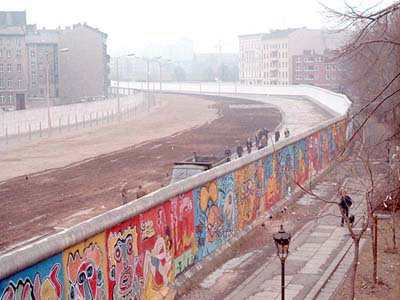Visitors search in vain for the Berlin Wall
 Berlin - In the 20th anniversary year since the fall of the Berlin Wall, visitors still flock to the once divided city.
Berlin - In the 20th anniversary year since the fall of the Berlin Wall, visitors still flock to the once divided city.
The Checkpoint Charlie museum in the city centre marks the spot where Russian and American tanks angrily squared up to one another in the crisis summer days of 1961.
In the middle of the road, a white hut marks the site of the old American control point. Two men in mock uniforms stand at the ready to satisfy tourists' requests for photographs.
At the former crossing point between the city's American and Soviet sector, visitors mill around during the Easter weekend.
The watchtowers are long gone, as are the zig-zag barricades designed to foil high-speed escapes and the corrugated metal roof that once spanned the roadway.
In their place, a monument reminds of 18-year-old Peter Fechter, shot whilst trying to scale the wall in 1962.
As the wounded teenager lay bleeding at the foot of the barrier, the West Berlin police heard his desperate cries for help and risked their lives, in vain, throwing first-aid packets over the barricades.
Founded in 1963, the museum also depicts some of the more bizarre escapes made during the Wall's 29-year-old history.
These include an improvised chair lift in which a family of three were whisked over the wall in 1965 and a rusty Opel car, armour-plated and concrete-lined to deflect bullets, which safely brought five people to the West in 1961.
"It seems incredible that a city the size of Berlin should have been divided by a wall, for the best part of 30 years," says American high school student Melanie Gibson after visiting the Museum.
"It's a pity there's so little evidence of the wall anymore. I'm surprised segments were not kept near Checkpoint Charlie, as a symbol of man's inhumanity to man," she says.
Nagai Kazuyoshi, 37, a Tokyo fashion designer on a two-week trip to Germany, disagrees. "After German reunification I could perhaps understand why Berliners wanted to get rid of all traces of the barrier."
Today, segments of the Berlin Wall are in Washington, Honolulu, Costa Rica and Tokyo, but in Berlin you have to search hard to find traces of what the communists called the "anti-fascist barrier".
A section of wall has been preserved in Bernauer Street, in the district of Wedding. But it is not in a central part of the city, and often gets overlooked by foreign visitors.
The official memorial site is complete with border fortifications, dog-runs and the so-called 'death strip'.
A start is also being made on restoring a 1.3 kilometre stretch of wall, known as the East Side Gallery in the district of Friedrichshain.
In the early 1990s, 118 international artists were invited to paint the blank stretch of wall, on the East side of the division.
Two famous East Side Gallery images show an East German Trabant car bursting through the wall, and former Soviet and East German leaders Leonid Brezhnev and Erich Honecker sharing a fraternal kiss.
Over the years, pollution, vandalism and weather have eroded the paintings. Berlin-based artist Kani Alavi has long canvassed the authorities to rescue the wall art works.
As a result, most of the original artists have now been tracked down around the world, and have agreed to return to redecorate the wall.
But not all artists realised their original paintings have been removed to make way for the new ones.
Dimitri Vrubel, who painted the clinch between Brezhnev and Honecker, was shocked when he returned to see bare concrete.
The Moscow-based artist told German daily Bild this was "an abuse of the participating artists." Vrubel refused to recreate his original image, the newspaper reported, quoting that he'd add "a brand-new piece of work, not a restoration."
Vrubel's Brezhnev-Honecker motif had been used on postcards, mugs and other memorabilia down the years.
Despite lessons from the past, Berlin's city authorities appear determined to keep the city's contemporary feel, even at the cost of historical reminders.
In recent years Berlin officials admitted it may have been a mistake to hastily dismantle the Wall when the city was reunified. To this day it remains one of Berlin's most iconic landmarks, despite the fact that so little of it remains.